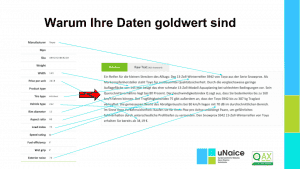Turn data into text – at the touch of a button

On the left: the product data with the attributes, which serve as input for the automatic text creation. On the right: a text variant, as it is then generated and output by the Text Robot.
The good news: A Text Robot “lives” on a raw material that companies usually own anyway: data. From this, unique text can be created automatically. And all of this in up to 119 languages and, if the text is published online, also relevant for SEO.
An obvious area of application for a Text Robot is the automated creation of product descriptions, for example for an online shop or a product catalogue. The available product data or, more precisely, the attributes contained therein suffice as “fodder” for the text robot. Let us take a closer look at this using an example:
This is the data of a product as it is stored in a database (PIM, ERP, Excel or similar) of an online home improvement store:
product_type: jigsaw
product_name: battery jigsaw Bosch PST
brand: Bosch
depth_of_cut_wood_mm: 80
depth_of_cut_steel_mm: 5
idling_stroke_number_min: 0
idling_stroke_number_max: 2400
pendulum_stroke_steps: 4
weight_with_battery_kg: 1,6
charging_time_min: 60
scope_of_delivery: 1 saw blade|1 CutControl|1 saw blade depot|1 tear protection|1 transparent cover
From this text data, the text robot can generate the following text for an online store, for example, after prior configuration:
Battery jigsaw Bosch PST 18 Li
Are you an experienced semi-professional and therefore regularly involved in manual work? With the Bosch PST 18 Li battery jigsaw, you can master any task with ease. It is a high-quality and reliable partner for sawing out shaped parts from thin plates, boards or even beams as well as an assembly saw and for adjustment work in the field.
Both wood and steel can be worked on with cutting depths of 80 and 5 mm respectively. The maximum number of strokes per minute lies between 0 and 2400. Equipped with 4 pendulum stroke steps, the saw cuts across a wide area. This results in a better ejection of the sawdust and more efficient sawing. In terms of weight, the jigsaw including battery only weighs 1.6 kg – for high precision and manageability. Dust extraction option and blowing function ensure clean work and a clear view.
The jigsaw is designed for diagonal and mitre cuts. With the charger, the battery of the jigsaw is topped up again within 60 minutes. With the delivery you will also receive 1 saw blade, 1 CutControl, 1 saw blade depot, 1 tear protection and 1 transparent cover guard.
The Bosch jigsaw has it all – just like you.
If you were to use exactly this data a second time and have the Text Robot produce a text again, it would look different. This is because our process ensures that every text produced is unique and therefore one-of-a-kind. An original text is an important criterion, especially in the field of e-commerce, because search engines love unique texts, whereas texts that are used several times lead to a drop in the Google ranking.
Incidentally, it is a common misconception that text robots are limited to the texting and description of technical products. Let us look at a second example:
This is the data of a product as it is stored in a database (PIM, ERP, Excel or similar) of a fashion shop:
product_type: fine knitted cardigan
gender: female
brand: Moda
colour: grey
material: cashmere|angora|viscose|polyamide|polyacrylics
style: romantic
closure: buttons
decoration: lace border
position_decoration: back hem
cut-out: V
cut: straight
shape: figure-hugging
number_of_pockets: 2
position_pockets: front
soft_feel: yes
After programming the Text Robot, taking into account the text concept desired by the customer – in terms of language style, future further development and tonality – the following product description text can be created from the data input:
Grey fine knitted cardigan for ladies by Moda
Are you a romantic? Then this grey fine knitted cardigan by Moda fits your style perfectly. It has a straight cut, a V-neck, buttons to close and a velvety soft feel.
It is equipped with two pockets on the front. Among other things, the finest cashmere and angora were used. The brand’s attention to detail is evident in the lace border on the back hem.
In addition, it has a figure-hugging shape and therefore fits particularly well.
A real piece to fall in love with – impress your counterpart with the Moda fine knit cardigan in grey!
No matter the line of business – only data is important
Conclusion: No matter what products are involved, no matter what industry we are talking about: Based on a text concept, impressive product texts can always be created from raw material data using text automation. And as far as the quality of the results is concerned, they are better than texts written by a human in terms of expertise and credibility.
This leaves the answer to the question of how text can be created from structured data. As already mentioned, the Text Robot needs to be programmed. The programming language (or rather markup language) used for this purpose is called ATML3 and was developed by the Stuttgart-based technology company AX-Semantics especially for text automation. and in the meantime even released. “This should enable AX Semantics’ products to be used in a variety of areas. This ranges from simple utility texts, reportings, product and financial texts to news, sports reports or other journalistic texts,” says AX Semantics CEO Saim Alkan.
And what role does uNaice play in this context? We have been a solution partner of AX Semantics from the very beginning, advising companies on possible applications of a Text Robot and implementing their projects from start to finish.
Is text automation limited to ecommerce?
The clear answer is no. The possibilities of use are almost endless. Here are a few inspirations:
Examples of functional text:
- iIndividual e-mails and newsletters with product recommendations based on customer data, as well as the possibility of providing information on where to purchase by showing the nearest shop carrying the item, using secondary data
- self-optimising Google Adwords campaigns
- individual text after configuration of a product (car, bicycle, computer, etc.)
- text for business management evaluations (optionally with recommendations for action)
- bank reports, individual credit offers, personal financial evaluations
- automatic text for webanalytics
- automatic text for real estate, fitness data, nutritional data, stock market data, etc.
Examples from the publishing sector:
- weather reports, horoscopes, TV programme
- new books and films
- news in the music market
- stock exchange and share reports
- coaching apps based on personal data (e.g. fitness, medicine, nutrition)
- crime reports based on police reports
- sports reports, bets and odds
In one of the next blog posts we will take a closer look at some specific application scenarios. Meanwhile, you can start thinking about what data is all lying dormant on your end, just waiting to be turned into valuable, high-conversion, informative copy. Don’t let your data lie around on a data cemetery – create added value from data and start with automatic text creation.
Further contributions on the topic of Text Robots:
